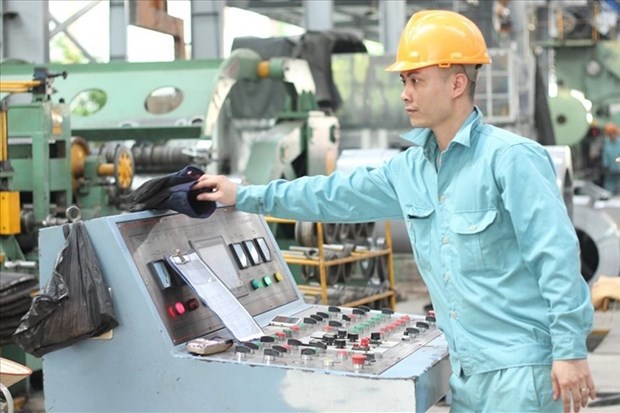Hanoi a bright spot in FDI attraction
 |
| Hanoi has attracted around 25 billion USD in foreign direct investment (FDI) over the last five years. (Photo: kinhtevn.com.vn) |
Hanoi has attracted around 25 billion USD in foreign direct investment (FDI) over the last five years, with priority given to quality and sustainable development, figures show.
The capital city took the lead nationwide in FDI attraction during the 2018 - 2019 period. Notably, it received some 3.28 billion USD in the first nine months of this year, amid the COVID-19 pandemic.
It currently has 6,278 FDI projects worth over 47.7 billion USD, of which 28.5 billion USD has been disbursed.
According to Director of the municipal Department of Planning and Investment Nguyen Manh Quyen, FDI accounts for 12.8 percent of the city’s total investment capital and 10.4 percent of the local budget.
Kyle Kelhofer, Country Manager for Vietnam, Cambodia and Laos at the International Finance Corporation (IFC), pointed to Hanoi’s advantages that favour high-tech projects, especially infrastructure and high-quality human resources.
Forty-one percent of Japanese firms, meanwhile, have considered expanding their operations in Vietnam over the next three years, according to Takeo Nakajima, Chief Representative of the Japan External Trade Organisation (JETRO) in Hanoi.
Hanoi should therefore bring into full play its position as one of the top 10 localities nationwide in the provincial competitiveness index (PCI), he suggested, in order to attract even more Japanese investment.
Experts, however, have said the city must address issues such as the slow development of industrial zones and clusters, high land rentals, and small-scale support industry, to attract high-quality FDI projects.
According to the municipal Department of Planning and Investment, Hanoi expects to attract 30-40 billion USD in FDI during the 2011-2025 period, of which 20 billion USD - 30 billion USD will be disbursed.
The number of businesses using cutting-edge technologies and modern management and environmental protection methods is expected to increase by 50 percent by 2025 compared to 2018, while the rate of locally-made content is to reach 30 percent.
To that end, Director of the Department of Planning and Investment Nguyen Manh Quyen said Hanoi will continue to target quality projects, especially with partners such as Japan, the United States and Europe, to step up technology transfer.
Minister of Planning and Investment Nguyen Chi Dung said that developing digital technology, precision mechanics, automation, and semi-conductor technology will push ahead with Hanoi’s industrialisation and modernisation.
He suggested the capital city develop a number of urban economic models, saying it is likely to become the country’s creative centre.
It is working to improve its business environment, devise a plan for the support industry by 2025, and complete industrial parks and clusters and transport infrastructure, while building e-government to make business registration and tax declarations and payments easier for enterprises.
Phan Duc Hieu, deputy head of the Central Institute for Economic Management at the Ministry of Planning and Investment (MPI), said Hanoi should employ mechanisms that help promote links between domestic and foreign firms, encourage multi-national groups to invest in the city, and develop creative and innovation centres.
Local authorities have regularly held dialogue with investors and helped them seek development opportunities by removing difficulties.
The “Hanoi: Investment and Development Cooperation” conference, which is held annually with the participation of a large number of investors, confirms the city is a safe and attractive investment destination.
Secretary of the municipal Party Committee Vuong Dinh Hue pledged at a recent meeting with representatives from the Ministry of Planning and Investment that Hanoi will further create optimal conditions for investors by working with them and sharing their difficulties.
Attracting FDI will raise the city’s competitiveness and materialise its target of rapid, sustainable, and modern development, he emphasised.
What the stars mean:
★ Poor ★ ★ Promising ★★★ Good ★★★★ Very good ★★★★★ Exceptional
Related Contents
Latest News
More News
- Can Tho utilises its growth advantages (December 15, 2025 | 09:09)
- Ca Mau unlocking potential to shape a more sustainable future (December 15, 2025 | 09:02)
- MoF workshop highlights mounting concerns over ODA on-lending costs (December 12, 2025 | 16:05)
- National Assembly approves pilot mechanisms to accelerate major projects in Hanoi (December 12, 2025 | 11:29)
- Legislation gives government flexibility for loan guarantees (December 11, 2025 | 18:04)
- Vietnam eases policy approval requirements, simplifies foreign and outbound investments (December 11, 2025 | 17:53)
- Vietnam masters core technologies of automobile value chain (December 11, 2025 | 17:46)
- VAL opens second line of largest soybean crushing complex in Southeast Asia (December 11, 2025 | 12:08)
- Vietnam urged to shore up supply-chain resilience amid global uncertainty (December 10, 2025 | 18:47)
- Unpacking new momentum in Vietnam’s M&A market (December 10, 2025 | 09:59)

 Tag:
Tag:





















 Mobile Version
Mobile Version